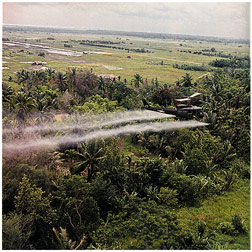Agent Orange Claims: Were You Exposed?
VETERANS WHO SERVED IN VIETNAM AND “IN COUNTRY” EVEN IF ONLY FOR A DAY, WERE EXPOSED TO AGENT ORANGE. BROWN WATER NAVY VETERANS AND BLUE WATER NAVY VETERANS WHO CAME ASHORE WERE ALSO EXPOSED TO AGENT ORANGE, AS WELL AS MANY OTHERS WHO SERVED DURING THE VIETNAM ERA.

PRESUMPTION OF EXPOSURE TO AGENT ORANGE
IF YOU SERVED “BOOTS ON THE GROUND” IN VIETNAM AND YOU NOW HAVE AN AGENT ORANGE PRESUMPTIVE DISEASE, THEN YOU MUST BE AWARDED SERVICE CONNECTED DISABILITY COMPENSATION. PERIOD.
KNOW YOUR RIGHTS WHEN IT COMES TO AGENT ORANGE DISABILITY CLAIMS.
Veterans’ Diseases Associated with Agent Orange
VA assumes that certain diseases can be related to a Veteran’s qualifying military service. These are called “presumptive diseases.”
VA has recognized certain cancers and other health problems as presumptive diseases associated with exposure to Agent Orange or other herbicides during military service. Veterans and their survivors may be eligible for disability compensation or survivors’ benefits for these diseases:
- AL Amyloidosis
A rare disease caused when an abnormal protein, amyloid, enters tissues or organs - Chronic B-cell Leukemias
A type of cancer which affects white blood cells - Chloracne (or similar acneform disease)
A skin condition that occurs soon after exposure to chemicals and looks like common forms of acne seen in teenagers. Under VA’s rating regulations, it must be at least 10 percent disabling within one year of exposure to herbicides. - Diabetes Mellitus Type 2
A disease characterized by high blood sugar levels resulting from the body’s inability to respond properly to the hormone insulin - Hodgkin’s Disease
A malignant lymphoma (cancer) characterized by progressive enlargement of the lymph nodes, liver, and spleen, and by progressive anemia - Ischemic Heart Disease
A disease characterized by a reduced supply of blood to the heart, that leads to chest pain - Multiple Myeloma
A cancer of plasma cells, a type of white blood cell in bone marrow - Non-Hodgkin’s Lymphoma
A group of cancers that affect the lymph glands and other lymphatic tissue - Parkinson’s Disease
A progressive disorder of the nervous system that affects muscle movement - Peripheral Neuropathy, Acute and Subacute
A nervous system condition that causes numbness, tingling, and motor weakness. Currently, it must be at least 10 percent disabling within one year of herbicide exposure and resolve within two years. VA proposed on Aug. 10, 2012, to replace “acute and subacute” with “early-onset” and eliminate the requirement that symptoms resolve within two years. - Porphyria Cutanea Tarda
A disorder characterized by liver dysfunction and by thinning and blistering of the skin in sun-exposed areas. Under VA’s rating regulations, it must be at least 10 percent disabling within one year of exposure to herbicides. - Prostate Cancer
Cancer of the prostate; one of the most common cancers among men - Respiratory Cancers (includes lung cancer)
Cancers of the lung, larynx, trachea, and bronchus - Soft Tissue Sarcomas (other than osteosarcoma, chondrosarcoma, Kaposi’s sarcoma, or mesothelioma)
A group of different types of cancers in body tissues such as muscle, fat, blood and lymph vessels, and connective tissues
Children with Birth Defects: VA presumes certain birth defects in children of Vietnam and Korea Veterans associated with Veterans’ qualifying military service.
Veterans with ALS: VA presumes amyotrophic lateral sclerosis (ALS) diagnosed in all Veterans who had 90 days or more continuous active military service is related to their service, although ALS is not related to Agent Orange exposure.
Source: U.S. Department of Veteran Affairs
38% ERROR RATE AT VA
The VA acknowledges it makes mistakes on 14 percent of disability claims – an error rate the agency considers unacceptable and has pledged to all but eliminate by 2015.
A CIR analysis of 18 audits published this year by the VA’s inspector general shows the problem could be much worse, especially in high-profile cases. The analysis found a 38 percent average error rate for claims involving disabilities like traumatic brain injury and illnesses linked to the Vietnam-era defoliant Agent Orange…more
EXPOSURE TO AGENT ORANGE BY LOCATION
Part of the United States’ strategy in Vietnam was to conduct an herbicide program to remove foliage providing cover for the enemy. Agent Orange was the most widely used of the herbicide combinations sprayed.
Agent Orange and other herbicides used in Vietnam were tested or stored elsewhere, including some military bases in the United States…more
INSTITUTE OF MEDICINE REPORTS ON AGENT ORANGE
VA contracts with the IOM of the National Academy of Sciences, a nongovernmental organization, to scientifically review evidence on the long-term health effects of Agent Orange and other herbicides on Vietnam Veterans. IOM determines whether the evidence points to a statistically valid association that would suggest or establish a relationship between diseases studied and herbicide use…
